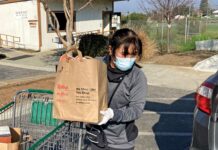It’s garden question-and-answers. Remember, you may e-mail
questions to ga*******@*ps.net. Or you can mail garden questions in
care of this newspaper. For a faster, personal response, please
include a self-addressed, stamped envelope.
It’s garden question-and-answers. Remember, you may e-mail questions to ga*******@*ps.net. Or you can mail garden questions in care of this newspaper. For a faster, personal response, please include a self-addressed, stamped envelope.
Q. I’m finding ants in my potted plants – both inside the house and outside. I’ve never had this problem with my houseplants before; it’s driving me nuts. What should I do?
– T.R., Hollister.
A: I’ve had this same problem with ants myself. As for the outside ants, they may not be doing any harm themselves. But if you look closely, you might see that they are hanging out with aphids, which are tiny insects that feed in masses on plant parts. Ants will feed on the waste product of aphids, called honeydew, because it is very sweet. If you can control the primary problem – usually aphids – you might control the ants as well. If you don’t see any aphids – and you won’t when it comes to your indoor houseplants – you can deal with the ants in two ways.
The first is a homemade bug spray: 1 gallon water, half-teaspoon of eucalyptus oil, 1 tablespoon vegetable oil and 1 tablespoon of liquid dishwashing soap. This concoction can be sprayed or poured on the ants. There are also commercial insecticides that will work.
The second remedy needs to be kept out of reaching of children and pets. It involves making a paste or bait out of boric acid powder and sweetened condensed milk. Add powder and milk until it has a consistency somewhat like fudge. Roll into small balls and place the ball where ants are a problem. The ants will carry the bait back to their nest where they share it with other ants who ingest it and die. There are commercial liquid baits like Antrol that will work as baits as well. They come in liquid forms or gel-like baits on stakes.
For your houseplants infested with ants, it may just be easier to repot. Take the infected plant outdoors and wash away all of the old soil from the roots (to get rid of any ant eggs. Then, repot with fresh soil. Ants like to nest in places where they won’t be disturbed and where there’s enough moisture, but not too much. That’s why you’ll find anthills near the driveway where it’s dry, but not in the lush, green lawn areas. If you water thoroughly every time you water by soaking the pot in a tub or bucket of water, you’ll discourage ants from living in the soil of containerized plants.
Q: I also have a bromeliad that’s lasted a year. The flowers just died. I would like to know how to care for it.
A: There are many different bromeliads, but their basic care is quite easy. They are typically slow growers, so take care not to overwater or overfeed.
They like average household temperatures and bright but not direct light, and will tolerate lower light conditions. Watering is minimal in that their roots are very sparse and you don’t want to rot things out.
You should try, though, to keep some water in the natural cup at the base of the plant where the foliage gathers together.
After blooming, you may find there are “pups” or baby plants developing around the older center. The pups can be gently separated off and repotted to make more plants.













